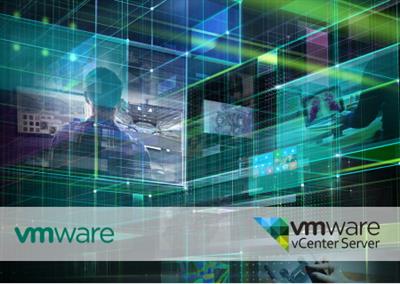VMware vCenter Server 7.0.0a x64
VMware vCenter Server 7.0.0a x64 | 6.2 GB
The VMware software development team is pleased to announce the availability of vCenter Server 7.0.0a is provides a centralized and extensible platform for managing virtual infrastructure.
VMware vCenter Server 7.0.0a Release Notes - Date: May 19 2020
Resolved Issues This issue is resolved in this release.
vSAN Issues
- vSphere Lifecycle Manager and vSAN File Services cannot be simultaneously enabled on a vSAN cluster
- In vCenter Server 7.0 systems, if vSphere Lifecycle Manager is enabled on a vSAN cluster, vSAN File Services cannot be enabled on the same cluster and vice versa.
- With vCenter Server 7.0.0a, the vSAN File Services and vSphere Lifecycle Manager are interoperable. You can enable both services at the same time.
VMware vSphere with Kubernetes Release Notes - Date: May 19 2020
New Features
Tanzu Kubernetes Grid Service for vSphere: rolling upgrade and services upgrade
- Customers can now perform rolling upgrades over their worker nodes and control plane nodes for the Tanzu Kubernetes Grid Service for vSphere, and upgrade the pvCSI, Calico, and authsvc services. This includes pre-checks and upgrade compatibility for this matrix of services.
- Rolling upgrades can be used to vertically scale worker nodes, i.e. change the VM class of your worker nodes to a smaller or larger size.
Supervisor cluster: new versions of Kubernetes, upgrade supported
- The Supervisor cluster now supports Kubernetes 1.17.4
- The Supervisor cluster now supports upgrading from Kubernetes 1.16.x to 1.17.x
Resolved Issues
Naming conflict for deleted namespaces
- We have resolved an issue where if a user deleted a vSphere namespace, and then created a new vSphere namespace with the same name, we had a naming collision that resulted in being unable to create Tanzu Kubernetes Grid workload clusters.
Improved distribution names
- We have made it clearer what version of Kubernetes you are running by removing OVF versioning information to a separate column.
VMware vCenter Server is the centralized monitoring and resource management software for VMware vSphere virtual infrastructure.
VMware vCenter Server performs a number of tasks, including resource provisioning and allocation, performance monitoring, workflow automation and user privilege management. It enables a vSphere administrator to manage multiple ESX and ESXi servers and virtual machines (VMs) through a single console.
Many key vSphere features, including VMware Distributed Resource Scheduler (DRS), vSphere High Availability (HA), vSphere Fault Tolerance (FT) and VMware vMotion, require vCenter Server to function.
The vCenter Server architecture consists of three main components: vSphere Web Client, vCenter Server Database and vCenter Single Sign-On.
The vSphere Web Client is a web application that acts as the vCenter Server user interface. It enables the administrator to manage installation and handle inventory objects in a vSphere deployment and provides console access to VMs. VMware introduced a new HTML5-based vSphere Client in vSphere 6.5; the company said it would retire the Flash-based web client in the next numbered version of vSphere.
The vCenter Server Database stores and manages server data, from inventory items to resource pools. Every instance of vCenter Server requires its own unique database. Introduced in vSphere 5.1, vCenter Single Sign-On (SSO) is an authentication broker and security token that enables the user to use one login to access the entire vSphere infrastructure without further authentication.
Multi-hypervisor management. VMware vCenter Server offers integrated management for VMware and Microsoft Hyper-V hosts.
VMware Host Profiles. This tool automates ESX and ESXi host configuration. A vSphere administrator can use Host Profiles to create a standard configuration, which serves as a sort of blueprint for all other hosts, and automate compliance to this configuration across all hosts or clusters.
Automatic VM restart. VMware vCenter Server uses vSphere HA to pool VMs and their hosts into a cluster. In the event of a server failure, vSphere HA will automatically restart these VMs on other hosts within the cluster.
Patch management. The vSphere Update Manager(VUM) automatically scans and patches ESXi hosts and certain Microsoft and Linux VMs.
vRealize Orchestrator (vRO). This vCenter Server plug-in, which integrates with vRealize Suite and vCloud Suite, automates tasks using workflows.
vRealize Log Insight for vCenter Server. This log management software has customizable dashboards that enable an administrator to analyze system log data, identify and troubleshoot issues, and check for system compliance.
vCenter Server Linked Mode. This feature provides an administrator with a single view of their vSphere deployment. An administrator can also use Linked Mode to connect multiple vCenter Server systems and grant them permission to share information. Linked Mode automatically replicates all new resources created by the administrator, including roles, policies and permissions, across the linked vCenter Server systems.
Application programming interfaces (APIs). VMware vCenter Server uses APIs to communicate and integrate with third-party software.
vCenter Server 7 arrives with many new features such as vCenter Server Profiles and Update Planner. Learn more about how vCenter Server 7 helps simplify Lifecycle operations in this video.
VMware software powers the world's complex digital infrastructure. The company's cloud, networking and security, and digital workspace offerings provide a dynamic and efficient digital foundation to customers globally, aided by an extensive ecosystem of partners. Headquartered in Palo Alto, California, VMware is committed to being a force for good, from its breakthrough innovations to its global impact.
Product: VMware vCenter Server
Version: 7.0.0a
Supported Architectures: x64
Website Home Page :
[Misafirler Kayıt Olmadan Link Göremezler Lütfen Kayıt İçin Tıklayın ! ]
Language: english
System Requirements: PC *
Size: 6.2 GB
DOWNLOAD LINKS :
Kod:https://nitroflare.com/view/D6B423A8B5574BE/VMware_vCenter_Server_7.0.0a_x64.part1.rar https://nitroflare.com/view/E48FB9EFB84F26E/VMware_vCenter_Server_7.0.0a_x64.part2.rar https://nitroflare.com/view/3C793FB9AB9FCD4/VMware_vCenter_Server_7.0.0a_x64.part3.rar https://nitroflare.com/view/8A66B054832ACC5/VMware_vCenter_Server_7.0.0a_x64.part4.rar https://nitroflare.com/view/266C02F3CCD9DED/VMware_vCenter_Server_7.0.0a_x64.part5.rar https://nitroflare.com/view/C15197DF1984667/VMware_vCenter_Server_7.0.0a_x64.part6.rar https://nitroflare.com/view/97CB0EF89314D6C/VMware_vCenter_Server_7.0.0a_x64.part7.rar https://rapidgator.net/file/ab7b52448a9110c5a250136ab7d0cac6/VMware_vCenter_Server_7.0.0a_x64.part1.rar.html https://rapidgator.net/file/bb7cc2388057524049c1f9c99f3951f7/VMware_vCenter_Server_7.0.0a_x64.part2.rar.html https://rapidgator.net/file/87d64a165e9a646455ba0ae6cb97be9b/VMware_vCenter_Server_7.0.0a_x64.part3.rar.html https://rapidgator.net/file/e08f9ddbb28e455ac483483c503d73d1/VMware_vCenter_Server_7.0.0a_x64.part4.rar.html https://rapidgator.net/file/f4a2f05db2cf2f270547aa8750622e43/VMware_vCenter_Server_7.0.0a_x64.part5.rar.html https://rapidgator.net/file/339af42765252b385bbcb4b73d4a49a5/VMware_vCenter_Server_7.0.0a_x64.part6.rar.html https://rapidgator.net/file/34ab061a3baea857bc69f8cd90262aba/VMware_vCenter_Server_7.0.0a_x64.part7.rar.html
1 sonuçtan 1 ile 1 arası
Threaded View
-
02.06.2020 #1Üye



- Üyelik tarihi
- 21.01.2020
- Mesajlar
- 3.112
- Konular
- 0
- Bölümü
- Biyomühendislik
- Cinsiyet
- Erkek
- Tecrübe Puanı
- 9
VMware vCenter Server 7.0.0a x64
Konu Bilgileri
Users Browsing this Thread
Şu an 1 kullanıcı var. (0 üye ve 1 konuk)



 LinkBack URL
LinkBack URL About LinkBacks
About LinkBacks





 Alıntı
Alıntı
Konuyu Favori Sayfanıza Ekleyin